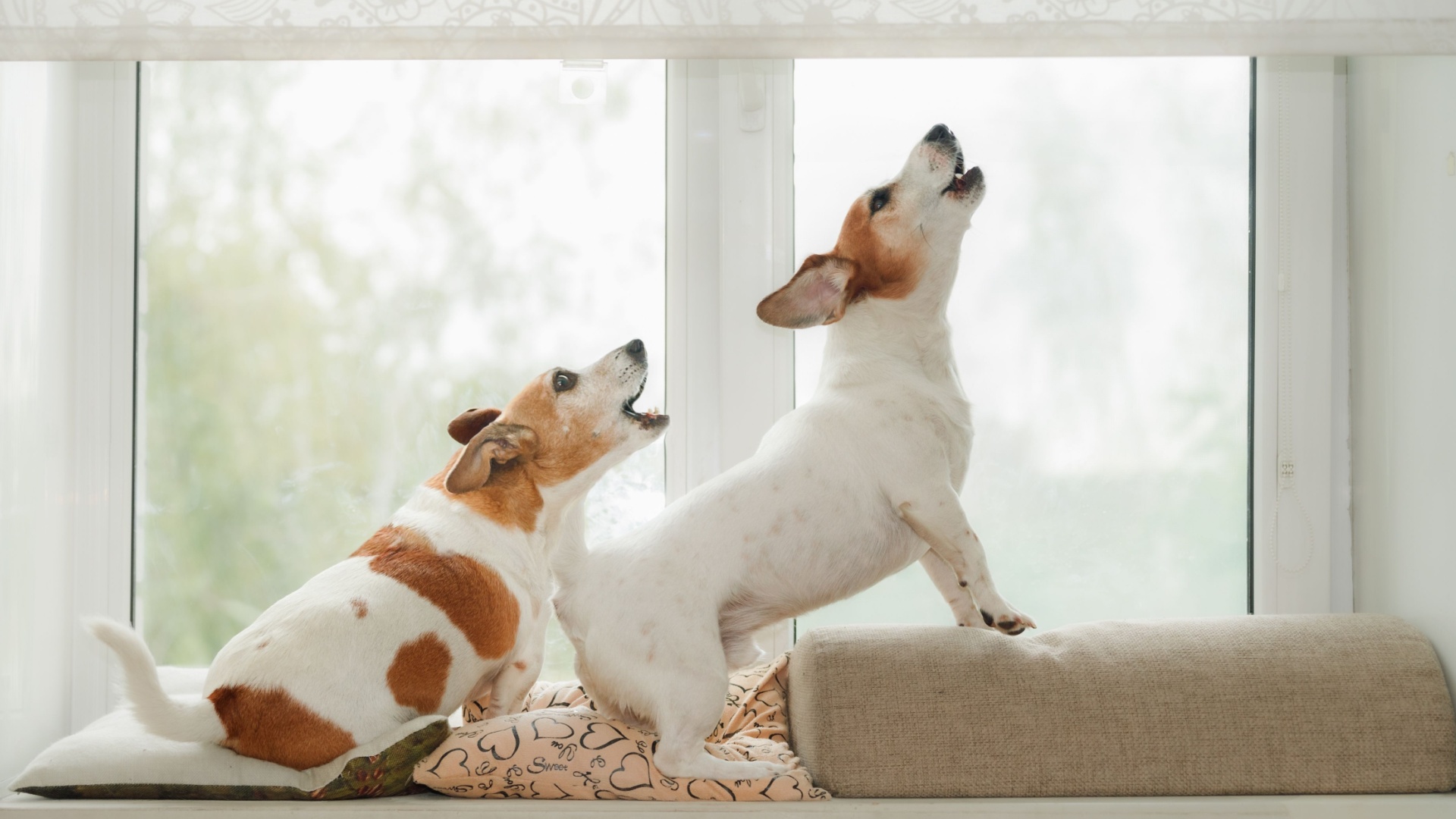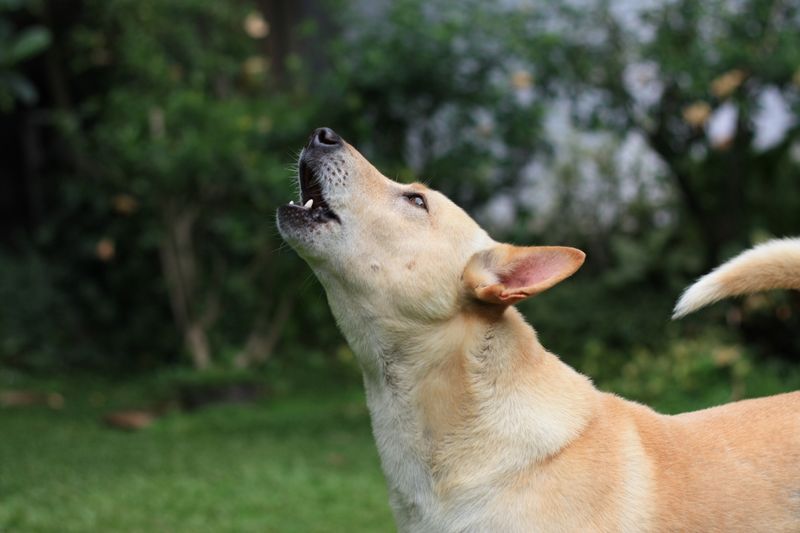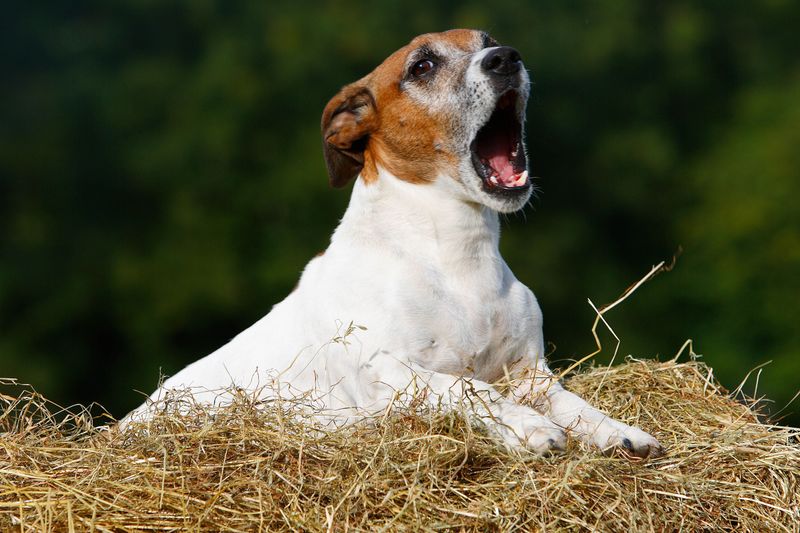13 Strange Sounds Your Dog Makes And The Meaning Behind Them

Have you ever caught your dog making a strange sound and wondered what on earth it could possibly mean? Dogs, our beloved furry friends, have a unique way of communicating through a variety of sounds that can often leave us puzzled.
From the mysterious howl that seems to echo through the night to the quirky snorts that accompany an enthusiastic play session, these sounds are more than just noise; they tell a story.
Get ready to explore the symphony of woofs, whines, and whimpers that make up the soundtrack of your dog’s life.
1. Howling

Howling is perhaps one of the most classic sounds associated with dogs. When your canine companion throws back their head and lets out a long, mournful howl, it’s enough to make you think of lonely wolves in the wild. But why do dogs howl, and what are they trying to say? This sound is often a form of communication, perhaps to alert others or respond to distant noises like sirens. It’s also a behavior rooted in their wolf ancestry, where howling was used to coordinate pack activities.
In some cases, dogs howl to get your attention or express anxiety. If your dog is howling excessively, it might be worth investigating whether they’re feeling stressed or lonely. On the other hand, some dogs simply howl for the joy of it, responding to musical instruments or even their favorite tunes on the radio. A good howl can be a dog’s way of singing along, creating their own canine symphony.
So next time your dog starts howling, listen closely. You might just find they’re trying to tell you something important or perhaps just aiming to join a cosmic choir under the stars.
2. Whining

Whining, that high-pitched, often incessant sound, can tug at a dog owner’s heartstrings like nothing else. Puppies are especially notorious for this, using it to signal a need, whether it’s hunger, discomfort, or a plea for playtime. In dog language, whining can be their way of saying, “I need something!” or “Pay attention to me!”
While it might be tempting to give in to your dog’s whining immediately, understanding the context is key. Are they standing by the door, asking to go outside? Or perhaps they’re eyeing the cookie jar with that plaintive look. It’s important to resist reinforcing negative behaviors by rewarding whining unnecessarily. Instead, teach your dog that calm behavior gets better results.
Whining can also indicate anxiety or stress, especially if it’s accompanied by pacing or other restless behaviors. In such cases, identifying the root cause and addressing it can help alleviate your dog’s distress. So, the next time your dog whines, listen not just with your ears, but with your heart, striving to understand what they truly need.
3. Barking

Barking is perhaps the most common sound dogs make, and it can mean a multitude of things. From excitement and alerting you to danger, to simply saying hello, a bark is versatile. The context of the bark often gives clues; a rapid, high-pitched bark might indicate excitement, while a slower, deeper bark may signal a warning or threat. Recognizing these nuances can help you interpret what your furry friend is trying to communicate.
Some breeds are more vocal than others, and barking can be a way for dogs to express their personality. Whether they’re alerting you to the mailman or enthusiastically greeting a new friend, barking is a key part of how dogs interact with the world.
It’s essential to manage excessive barking, as it can become disruptive. Training your dog to understand when barking is appropriate can improve your relationship and keep the peace in your household. Whether it’s through positive reinforcement, distraction techniques, or teaching commands, balancing your dog’s need to bark with your own need for quiet is an art worth mastering.
4. Growling

Growling often gets a bad rap, but it’s one of the most important sounds in a dog’s vocabulary. Contrary to popular belief, growling isn’t always a sign of aggression. It can be a way for dogs to express discomfort, fear, or even playfulness. Think of it as your dog’s way of saying, “something’s not quite right here.”
When a dog growls, it’s crucial to pay attention to their body language. Are they sending warning signals, or are they simply engaging in a game of tug-of-war? Understanding the context can help you respond appropriately and prevent misunderstandings.
Ignoring a growl can lead to more serious issues, as it’s often a precursor to a snap or bite. By acknowledging your dog’s growl and analyzing the situation, you can address their concerns and prevent conflict. So, next time you hear that low, rumbling sound, don’t panic. Instead, see it as an opportunity to communicate and strengthen your bond with your furry friend.
5. Snorting

Snorting might sound odd, but it can be rather endearing. This sound is often heard during playtime, when your dog is rolling around in the grass or engaging in some rough-and-tumble fun. It’s their way of expressing joy and excitement, much like laughter in humans.
However, snorting can also occur when a dog is experiencing something known as a “reverse sneeze.” This is more common in short-nosed breeds like pugs and bulldogs. The sound can be alarming, but it’s usually harmless and tends to resolve on its own. If it happens frequently, though, it might be worth consulting a vet to rule out any underlying issues.
In essence, snorting is one of those quirky sounds that adds character to your dog’s vocal repertoire. It’s a reminder that dogs, like humans, have their own unique way of experiencing the world, and sometimes, that experience includes a little snort of happiness. So, embrace the snorts and giggles, as they are part of what makes your dog truly special.
6. Sighing

When your dog lets out a long, deep sigh, it’s almost as if they’re saying, “Ah, life is good.” Sighing is a sign of contentment and relaxation, often occurring when your dog is winding down for a nap or enjoying a quiet moment with their favorite human.
But sighing can also indicate boredom or frustration, especially if accompanied by a long, soulful gaze. It might be your dog’s way of telling you, “I’m tired of waiting,” or “I’m feeling a bit neglected here.” In these cases, a little extra attention or a new activity can go a long way.
Ultimately, sighing is a multifaceted sound that reflects your dog’s emotional state. Whether it’s a contented sigh of happiness or a dramatic expression of impatience, it’s a sound that adds depth to your dog’s character. So, the next time your dog sighs, take it as an opportunity to connect and share a moment of peace together.
7. Chuffing

Chuffing, also known as “huffing,” is a lesser-known sound that dogs make, and it’s full of charm. This soft, breathy sound is often used as a friendly greeting, a way for dogs to say, “Hey there, I’m happy to see you!” It’s similar to a cat’s purr, conveying a sense of comfort and affection.
Chuffing can also occur when a dog is excited or wants to play. It’s a playful invitation, an expression of joy that invites interaction. If you hear your dog chuffing, consider it a green light for some quality bonding time.
In some cases, chuffing might be a sign of mild irritation or impatience, but it’s typically a sound of good nature. It’s a unique part of your dog’s communication toolbox, adding a gentle, endearing touch to their interactions. So, embrace the chuffing and enjoy the special language of love your dog shares with you.
8. Panting

Panting is a sound that every dog owner is familiar with. It’s the rhythmic, often rapid breathing that dogs use to cool down, especially after exercise or in warm weather. Unlike humans, dogs don’t sweat through their skin, so panting is essential for regulating their body temperature.
But panting can also be a sign of excitement, nervousness, or even pain. If your dog is panting heavily without an obvious cause, it might be worth investigating further. Are they stressed about something? Could they be feeling unwell? Paying attention to the context and accompanying behaviors can provide valuable clues.
Panting is a natural and necessary part of a dog’s life, but it’s also a window into their current state of mind. Whether it’s a happy pant after a vigorous play session or a sign of anxiety, being attuned to this sound helps you understand and respond to your dog’s needs. It’s a reminder that even in the simplest of actions, our dogs are communicating with us.
9. Yelping

Yelping, that sharp, high-pitched sound, is usually a dog’s way of saying, “Ouch!” or “Whoa, that was unexpected!” It’s often heard during play when things get a bit too rough or when a dog is startled by something surprising. A yelp can be a clear indicator that your dog needs a moment to assess the situation.
While it may be alarming to hear, yelping is a normal part of a dog’s communication. It serves as a boundary, signaling to other dogs (or humans) that something is amiss. If your dog yelps frequently, though, it might be a good idea to ensure they’re not experiencing any discomfort or injury.
In multi-dog households, yelping can be a way for dogs to self-regulate their play, teaching each other about limits and boundaries. It’s a crucial part of socialization and helps foster healthy relationships. So, when your dog yelps, listen closely and offer reassurance, ensuring they’re safe and comfortable.
10. Whimpering

Whimpering, a soft, plaintive sound, can be heart-wrenching to hear. It often conveys a sense of vulnerability, an expression of need or unease. Puppies are particularly prone to whimpering, using it to seek reassurance or companionship from their human caregivers.
When your dog whimpers, it’s important to assess the context. Are they separated from you, feeling lonely or anxious? Or perhaps they have a physical discomfort that needs attention. Whimpering can be a dog’s way of reaching out, asking for comfort or help.
Addressing the underlying cause of whimpering is crucial for your dog’s well-being. Whether it means offering a comforting cuddle, engaging in a calming activity, or consulting a vet for health concerns, responding to your dog’s whimper can strengthen your bond and enhance their sense of security. It’s a gentle reminder that your dog relies on you as their pillar of support and love.
11. Huffing

Huffing, a breathy exhalation, can be an intriguing sound in a dog’s vocal repertoire. Often mistaken for a sneeze, huffing is typically a sign of curiosity or mild agitation. It’s your dog’s way of saying, “I’m not so sure about this,” and can occur when they’re assessing a new situation or encountering someone unfamiliar.
In some instances, huffing might be a prelude to barking, serving as an initial warning before escalating to more vocal communication. It’s a subtle sound, but one that carries meaning, reflecting your dog’s alertness and awareness.
Understanding huffing helps you gauge your dog’s comfort level and assess potential stressors. Whether it’s a new visitor or an unexpected noise, acknowledging and addressing your dog’s huffing allows you to provide reassurance and support. It’s a small but valuable insight into your dog’s world, inviting you to explore their perceptions and reactions.
12. Bay

Bay, a sound characteristic of hound breeds, is a unique blend of barking and howling. It’s often used when a dog is on the hunt, signaling excitement and tracking the scent of prey. This sound echoes the thrill of the chase, a primal call that dates back to their ancestors.
Baying can be heard in other contexts too, such as when a dog is trying to communicate with other dogs or announce their presence. It’s a distinctive sound, one that sets hounds apart and showcases their instinctual drive.
For non-hound owners, baying might seem unusual, but it’s a fascinating glimpse into a dog’s heritage. Embracing this sound means recognizing the deep-seated instincts that drive your dog’s behaviors and appreciating the rich tapestry of their communication skills. Whether it resonates through a forest or your living room, baying is a celebration of your dog’s unique spirit and vitality.
13. Snoring

Snoring is a sound that brings a smile to the faces of many dog owners. It’s the gentle rumble that can accompany your dog’s slumber, offering a sense of calm and relaxation. While not all dogs snore, it’s more common in breeds with shorter snouts, like bulldogs and pugs.
Though often harmless, excessive snoring might indicate a problem, such as obesity or a respiratory issue. If your dog’s snoring is loud or disruptive, it’s worth discussing with a vet to ensure their health isn’t compromised.
Snoring is part of the charm that makes each dog unique. It adds a soundtrack to their resting hours, a peaceful reminder of the simple joys of life. So, when your dog snores, let it lull you into a shared moment of tranquility, a testament to the comfort and safety they feel in your presence.






